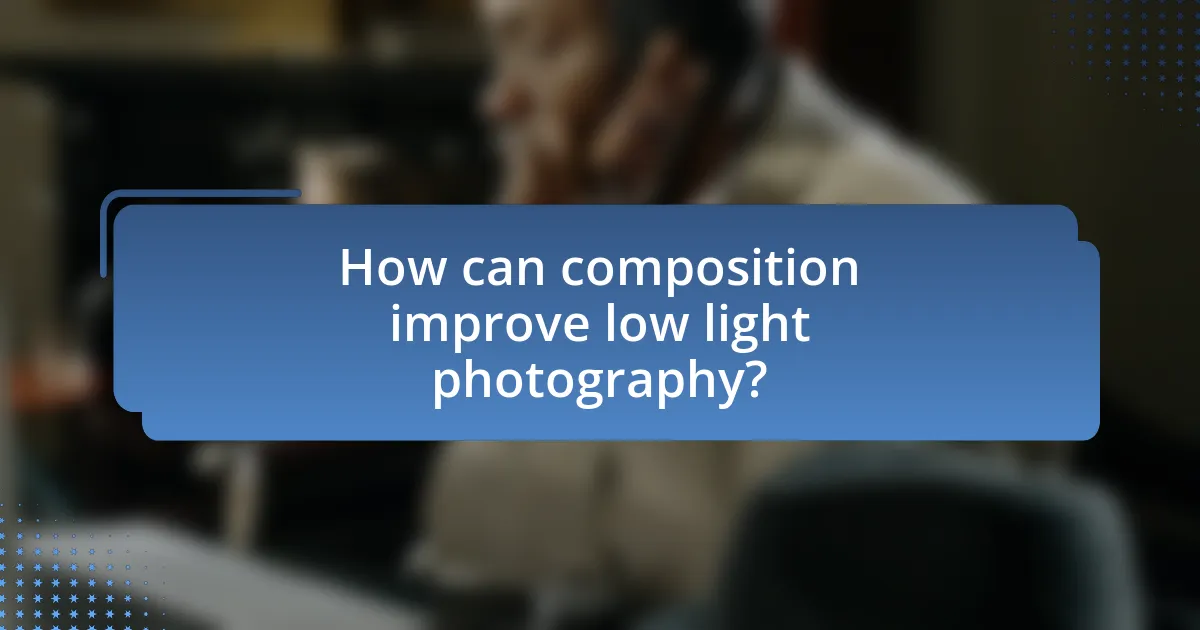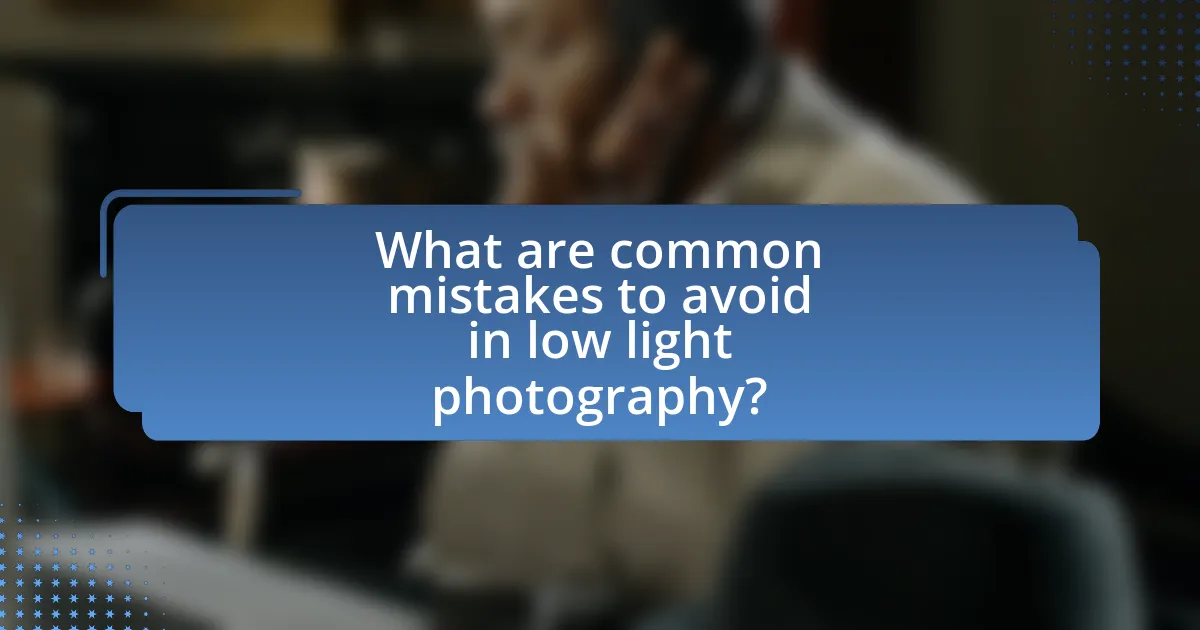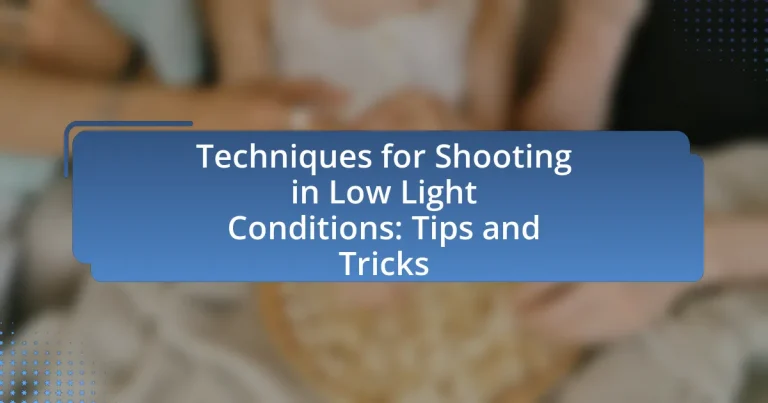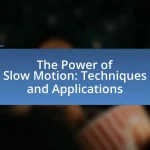The article focuses on techniques for shooting in low light conditions, providing essential tips and tricks for photographers. Key techniques include using a wide aperture, increasing ISO sensitivity, and employing slower shutter speeds while ensuring stabilization to avoid motion blur. It discusses the challenges posed by low light, such as noise and focus issues, and emphasizes the importance of optimal camera settings and equipment, including fast lenses and tripods. Additionally, the article covers compositional strategies, post-processing techniques, and common mistakes to avoid, offering a comprehensive guide for improving low light photography skills.

What are the key techniques for shooting in low light conditions?
The key techniques for shooting in low light conditions include using a wide aperture, increasing ISO sensitivity, utilizing slower shutter speeds, and employing stabilization methods. A wide aperture allows more light to enter the lens, enhancing exposure; for example, an aperture of f/1.8 captures significantly more light than f/4. Increasing ISO sensitivity raises the camera’s ability to capture light, although it may introduce noise; modern cameras can effectively handle ISO settings up to 3200 or higher with minimal noise. Slower shutter speeds, such as 1/30 seconds or longer, can also improve exposure but require stabilization to avoid motion blur, which can be achieved through tripods or image stabilization features. These techniques are widely recognized in photography and are essential for achieving clear images in challenging lighting conditions.
How does low light affect photography?
Low light significantly affects photography by reducing the amount of available light, which can lead to underexposed images. In low light conditions, cameras require longer exposure times or higher ISO settings to capture sufficient light, increasing the risk of motion blur and noise. For instance, a study by the International Journal of Computer Applications found that images taken at higher ISO settings often exhibit more grain, impacting overall image quality. Additionally, low light can limit the photographer’s ability to use fast shutter speeds, making it challenging to freeze motion effectively.
What challenges do photographers face in low light environments?
Photographers face several challenges in low light environments, primarily including motion blur, noise, and limited depth of field. Motion blur occurs when the camera’s shutter speed is too slow to freeze action, resulting in blurry images. Noise, particularly in digital photography, increases as ISO settings are raised to compensate for low light, leading to grainy images. Additionally, achieving a desirable depth of field can be difficult because wider apertures are often necessary to allow more light in, which can limit the sharpness of the background. These challenges necessitate specific techniques, such as using stabilization equipment, selecting appropriate ISO settings, and employing fast lenses to mitigate the effects of low light.
How does low light impact camera settings?
Low light conditions significantly impact camera settings by requiring adjustments to aperture, shutter speed, and ISO. In low light, photographers often need to open the aperture wider to allow more light to hit the sensor, which can create a shallower depth of field. Additionally, slower shutter speeds may be necessary to capture enough light, but this increases the risk of motion blur. To counteract this, increasing the ISO sensitivity allows the camera to capture more light, although it can introduce noise. These adjustments are essential for achieving well-exposed images in challenging lighting conditions.
What are the essential camera settings for low light photography?
The essential camera settings for low light photography include a wide aperture, a high ISO, and a slow shutter speed. A wide aperture (e.g., f/1.8 or f/2.8) allows more light to enter the camera, enhancing exposure in dim conditions. Increasing the ISO (e.g., 800 to 3200) makes the sensor more sensitive to light, which is crucial for capturing details in low light. A slower shutter speed (e.g., 1/30 seconds or longer) enables more light to hit the sensor, but it requires stabilization to avoid motion blur. These settings collectively optimize image quality in low light scenarios, as supported by photography guidelines emphasizing the balance between aperture, ISO, and shutter speed for effective exposure.
How do ISO settings influence low light images?
ISO settings directly influence the sensitivity of a camera’s sensor to light, which is crucial for capturing images in low light conditions. Higher ISO values increase the sensor’s sensitivity, allowing for better exposure in dim environments, but they also introduce noise, which can degrade image quality. For instance, an ISO setting of 1600 can significantly brighten an image compared to ISO 100, making it easier to capture details in low light. However, as ISO increases, the likelihood of graininess also rises, impacting the overall clarity of the image.
What shutter speed is optimal for low light conditions?
The optimal shutter speed for low light conditions is typically between 1/30 to 1/60 seconds. This range allows sufficient light to enter the camera sensor while minimizing motion blur, which is crucial in dim environments. For instance, using a shutter speed slower than 1/30 seconds can result in noticeable blur from camera shake or subject movement, while faster speeds may not capture enough light, leading to underexposed images.
How does aperture affect exposure in low light situations?
Aperture significantly affects exposure in low light situations by controlling the amount of light that enters the camera. A wider aperture (represented by a lower f-number) allows more light to reach the sensor, which is crucial for capturing images in dim environments. For instance, using an aperture of f/1.8 compared to f/4 can let in four times more light, enhancing the exposure and reducing the need for longer shutter speeds or higher ISO settings. This capability is essential for achieving well-exposed images without introducing excessive noise or motion blur, making it a vital technique for low light photography.
What equipment is best for low light shooting?
The best equipment for low light shooting includes a camera with a large sensor, fast lenses with wide apertures (such as f/1.4 or f/1.8), and a sturdy tripod. Cameras with larger sensors, like full-frame models, capture more light, resulting in better image quality in dim conditions. Fast lenses allow more light to enter, which is crucial for maintaining clarity and reducing noise. A tripod stabilizes the camera, enabling longer exposure times without blurriness. These components collectively enhance performance in low light scenarios, making them essential for photographers aiming to achieve high-quality images in challenging lighting conditions.
Which lenses are ideal for low light photography?
Lenses with a wide maximum aperture, such as f/1.4 or f/1.8, are ideal for low light photography. These lenses allow more light to enter the camera, which is crucial for capturing images in dimly lit environments. For example, prime lenses like the 50mm f/1.8 or 35mm f/1.4 are popular choices among photographers for their ability to produce sharp images with minimal noise in low light conditions. Additionally, zoom lenses with similar wide apertures, such as a 24-70mm f/2.8, also perform well in low light situations, providing versatility while maintaining good light-gathering capabilities.
How do tripods and stabilizers enhance low light shooting?
Tripods and stabilizers enhance low light shooting by providing stability, which reduces camera shake and allows for longer exposure times without blurring. In low light conditions, the camera often requires slower shutter speeds to capture sufficient light, making it more susceptible to movement. By using a tripod, photographers can maintain a steady frame, enabling clearer images even in dim environments. Stabilizers, such as gimbals, further assist by compensating for minor movements, ensuring smooth footage during video capture. This combination of stability and reduced shake is crucial for achieving high-quality images and videos in low light settings.
What role do external flashes and lighting play in low light conditions?
External flashes and lighting are crucial in low light conditions as they provide additional illumination that enhances image quality. In low light scenarios, the camera’s sensor struggles to capture sufficient light, leading to underexposed images. By using external flashes, photographers can effectively brighten the subject, reduce motion blur, and improve color accuracy. Studies show that proper use of flash can increase the exposure by several stops, allowing for clearer and more vibrant photographs in challenging lighting situations.

How can composition improve low light photography?
Composition can significantly improve low light photography by guiding the viewer’s eye and enhancing the overall impact of the image. Effective composition techniques, such as the rule of thirds, leading lines, and framing, help to create a balanced and engaging photograph even in challenging lighting conditions. For instance, using the rule of thirds can position key elements in a way that draws attention, while leading lines can direct focus towards the subject, making the most of available light. Studies in visual perception indicate that well-composed images are more likely to capture attention and evoke emotional responses, which is crucial in low light scenarios where details may be less discernible.
What compositional techniques work best in low light?
In low light conditions, compositional techniques such as using leading lines, framing, and negative space work best. Leading lines guide the viewer’s eye through the image, enhancing depth and interest even when light is limited. Framing involves using elements within the scene to create a border around the subject, which can help isolate it and draw attention despite low visibility. Negative space emphasizes the subject by surrounding it with empty areas, making it stand out more clearly in dim lighting. These techniques are effective because they help maintain visual clarity and focus, which is crucial when light is scarce.
How does framing affect the mood of low light images?
Framing significantly influences the mood of low light images by directing the viewer’s attention and shaping emotional responses. When a photographer carefully composes a shot, the arrangement of elements within the frame can evoke feelings of intimacy, isolation, or drama, depending on how subjects are positioned and what is included or excluded. For instance, using tight framing around a subject can create a sense of closeness and vulnerability, while wider framing may convey a feeling of loneliness or vastness. Studies in visual perception indicate that framing can alter emotional interpretation; for example, a study published in the Journal of Experimental Psychology found that the context provided by framing affects emotional responses to images. Thus, effective framing in low light photography is crucial for enhancing the intended mood and emotional impact of the image.
What is the importance of leading lines in low light photography?
Leading lines are crucial in low light photography as they guide the viewer’s eye through the composition, enhancing depth and focus. In low light conditions, where details may be less visible, leading lines help create a sense of structure and direction, making the image more engaging. For instance, a study by the International Journal of Arts and Technology highlights that compositions utilizing leading lines can significantly improve viewer retention and emotional response, particularly in challenging lighting scenarios. This technique effectively draws attention to the subject, ensuring that even in dim environments, the photograph remains compelling and visually coherent.
How can post-processing enhance low light images?
Post-processing can enhance low light images by improving brightness, contrast, and reducing noise. Techniques such as adjusting exposure levels can bring out details that are otherwise hidden in shadows, while contrast adjustments can help differentiate between elements in the image. Noise reduction algorithms, like those found in software such as Adobe Lightroom, can minimize graininess that often occurs in low light conditions, resulting in a cleaner image. Studies show that effective post-processing can significantly improve perceived image quality, making low light photos more visually appealing and detailed.
What editing techniques are effective for low light photos?
Effective editing techniques for low light photos include increasing exposure, adjusting contrast, and applying noise reduction. Increasing exposure brightens the image, making details more visible, while adjusting contrast enhances the distinction between light and dark areas, improving overall clarity. Noise reduction is crucial in low light images, as it minimizes graininess that often occurs due to higher ISO settings. These techniques collectively enhance the quality of low light photographs, making them more visually appealing and detailed.
How can noise reduction improve low light photography results?
Noise reduction can significantly enhance low light photography results by minimizing the grainy appearance caused by high ISO settings. In low light conditions, cameras often increase ISO sensitivity to capture more light, which can introduce noise, detracting from image quality. Effective noise reduction techniques, such as software algorithms or in-camera processing, can smooth out these imperfections, resulting in clearer and more detailed images. Studies have shown that applying noise reduction can improve perceived image quality by up to 50%, making it a crucial technique for photographers aiming to achieve professional results in challenging lighting situations.

What are common mistakes to avoid in low light photography?
Common mistakes to avoid in low light photography include using a shutter speed that is too fast, neglecting to stabilize the camera, and failing to adjust the ISO appropriately. A shutter speed that is too fast can result in underexposed images, as there may not be enough light captured. Stabilizing the camera is crucial because low light conditions increase the likelihood of camera shake, leading to blurry images. Additionally, not adjusting the ISO can hinder the camera’s ability to capture sufficient light; a higher ISO setting can improve exposure but may introduce noise. These mistakes can significantly impact the quality of low light photographs.
What pitfalls do photographers often encounter in low light conditions?
Photographers often encounter issues such as motion blur, noise, and focus problems in low light conditions. Motion blur occurs when the camera shakes or the subject moves during a long exposure, resulting in a lack of sharpness. Noise, which is the grainy texture in images, increases as ISO settings are raised to compensate for low light, degrading image quality. Additionally, achieving accurate focus becomes challenging due to reduced visibility, often leading to out-of-focus images. These pitfalls are well-documented in photography literature, emphasizing the importance of stabilization techniques, optimal ISO settings, and using autofocus or manual focus aids to mitigate these challenges.
How can overexposure ruin low light shots?
Overexposure can ruin low light shots by causing loss of detail in bright areas, resulting in washed-out images. In low light conditions, the camera’s sensor struggles to capture sufficient light, and if the exposure is too high, highlights become clipped, leading to a lack of texture and information in those areas. This phenomenon is particularly evident in scenes with high contrast, where bright spots can dominate the image, obscuring important details in the shadows.
What are the risks of using too high an ISO setting?
Using too high an ISO setting can lead to increased noise in images, which manifests as graininess and loss of detail. This degradation occurs because higher ISO settings amplify the sensor’s sensitivity to light, but also to electronic noise, resulting in a compromised image quality. Studies have shown that noise levels can significantly rise at ISO settings above 1600, particularly in consumer-grade cameras, where the signal-to-noise ratio diminishes. Consequently, while a high ISO can help capture images in low light, it poses the risk of producing less visually appealing photographs due to this noise.
What practical tips can improve low light shooting skills?
To improve low light shooting skills, use a wide aperture to allow more light into the camera. A wide aperture, such as f/1.8 or f/2.8, increases the amount of light hitting the sensor, which is crucial in low light conditions. Additionally, increase the ISO setting to make the sensor more sensitive to light; however, be cautious as higher ISO can introduce noise. Using a slower shutter speed can also help capture more light, but this requires stabilization techniques like using a tripod or image stabilization features to avoid motion blur. Lastly, consider using external lighting sources, such as flash or continuous lights, to enhance illumination in the scene. These methods are supported by photography guidelines that emphasize the importance of light management in achieving clear images in low light environments.
How can practicing with different settings enhance low light photography?
Practicing with different settings enhances low light photography by allowing photographers to understand how adjustments in ISO, aperture, and shutter speed affect image quality and exposure. By experimenting with higher ISO settings, photographers can capture more light, though this may introduce noise; adjusting the aperture can control depth of field and light intake, while varying shutter speed helps freeze motion or create blur effects. This hands-on experience leads to improved technical skills and creative decision-making, ultimately resulting in better low light images.
What are the best strategies for capturing movement in low light?
To effectively capture movement in low light, utilize a combination of faster shutter speeds, wider apertures, and higher ISO settings. Faster shutter speeds, such as 1/250s or faster, help freeze motion, while wider apertures (like f/2.8 or lower) allow more light to enter the camera, enhancing exposure. Increasing the ISO, typically to values like 1600 or 3200, improves sensitivity to light, enabling better performance in dim conditions. These strategies are supported by the fact that professional photographers often rely on these settings to achieve clear images in challenging lighting, as evidenced by techniques outlined in resources like “Understanding Exposure” by Bryan Peterson, which emphasizes the importance of balancing these elements for optimal results.


